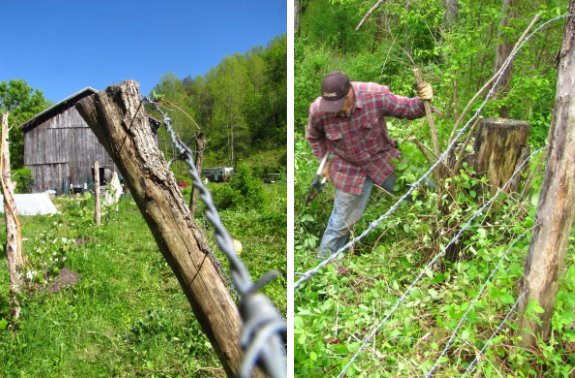
Walnut fence post 5 year field report

5 years ago we put up a
barbed wire fence on a limited budget.
One of the corners we cut was
using several walnut posts because we ran out of cedar and spent most
of the budget on 2 rolls of barbed wire and a new chain for the
chainsaw.
Fast forward to today when I
spent the afternoon taking part of that fence out and you can see why
walnut is a poor choice to use as a fence post. It's still a solid
piece of wood above ground, but each one I tried to remove ended up
breaking off at the base. If I had to guess I'd say a walnut post can
be expected to fail somewhere between 3 and 5 years, maybe more in a
dryer climate.
Want more in-depth information? Browse through our books.
Or explore more posts by date or by subject.
About us: Anna Hess and Mark Hamilton spent over a decade living self-sufficiently in the mountains of Virginia before moving north to start over from scratch in the foothills of Ohio. They've experimented with permaculture, no-till gardening, trailersteading, home-based microbusinesses and much more, writing about their adventures in both blogs and books.
Want to be notified when new comments are posted on this page? Click on the RSS button after you add a comment to subscribe to the comment feed, or simply check the box beside "email replies to me" while writing your comment.

Daddy --- good point! I kept meaning to post some photos I took of a cedar post I used for our clothesline (but the garden always seems more interesting. ) I put the posts in the ground a couple of years ago and the thicker post is still good, but the post that was only about 5 inches in diameter cracked over the winter. When I pulled it out, I could see that the red heartwood was still firm...but since it was only about an inch thick, it couldn't hold up the weight of my wet clothes. There's probably a formula somewhere (or should be) about how big the heartwood is for a certain diameter cedar so you can see if it will hold up in the long run.
) I put the posts in the ground a couple of years ago and the thicker post is still good, but the post that was only about 5 inches in diameter cracked over the winter. When I pulled it out, I could see that the red heartwood was still firm...but since it was only about an inch thick, it couldn't hold up the weight of my wet clothes. There's probably a formula somewhere (or should be) about how big the heartwood is for a certain diameter cedar so you can see if it will hold up in the long run.
Everett --- Thanks! Don't know if we'll ever take you up on that, though.
Regarding black locust: those trees bear wonderful wood once cut and milled. But the trees themselves are ones only a masochist count love. I've personally had a BL thorn punch through the sole of a Timberland work boot, a Ford F-250 tire, and the tire on a JOHN DEERE TRACTOR on the SAME DAY.
I'm a woodworker and own a portable mill. I will sometimes go on salvage missions for slabs when an old hardwood falls/gets hit by lightning, gets hits by a tornado, etc., both to slab the trunk and assist the people in question. Depending on the species/age of the tree, sometimes I even pay the landowner.
Black Locust I won't attend even if someone's paying ME. Great wood, great for the forest, great for bees... but, not to put too fine a point on it, those trees can take a long walk through a short wildfire. Mean, spiteful, hateful plants that have it in for you, personally. Mark my words.
-Z-